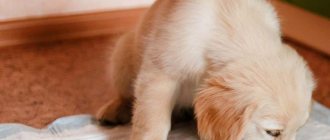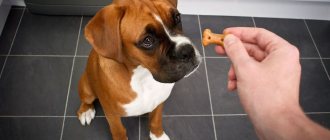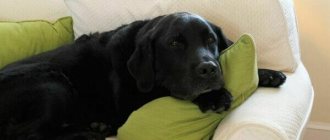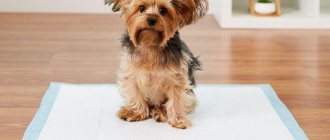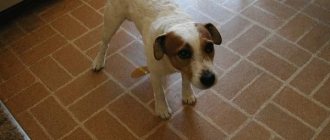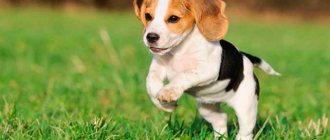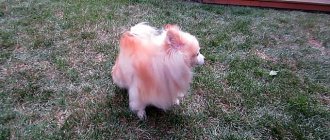How to accustom a puppy to a diaper at 1 month
You need to prepare for the arrival of a small family member in advance - remove carpets and shoes.
The floor should have a covering that is easy to clean, wash, or don’t mind throwing away when the baby grows up. You should be prepared for the fact that the puppy will go to the toilet anywhere, in a chaotic manner. It is advisable to cover all favorite places with diapers. You can’t toilet train a small creature, it’s just an introduction. Scolding is also pointless, he cannot control the urge.
How to accustom a puppy to a diaper at 2 months
By two months, you can reduce the number of diapers, since the desire to go to the toilet is not as frequent. Puppies go to the toilet after sleeping, active games, or eating.
You need to seize the moment and carry the baby to the canvas. Praise if everything was successful. Mistakes will happen because the dog has not yet fully understood the meaning of the training. Don't worry, she will definitely learn her lesson.
How to accustom a puppy to a diaper at 3 months
It is best to pick up the baby from the nursery at this age, when vaccinations have been completed and you can introduce him to the streets. But there is a chance that the previous owner did not teach him to go to the toilet in a diaper, you will need to make an effort.
The little dog is already aware of the urge; you need to take him to the toilet after sleeping and eating. If he has peed in the wrong place, you should blot the stain with a cloth and put the puppy on a diaper. But this should be done immediately after urination.
Don’t use force, don’t poke your baby’s nose into a puddle, don’t shout - this will create fear, the problem will not be solved. And gradually accustom the puppy to the street, start introducing him to the leash and collar at home.
How to train a puppy to wear a diaper at 4 months
At this age, awareness comes, the puppy begins to control the processes of urination and defecation. Now one or two diapers are enough, there is no need to cover the whole apartment with them.
There will be mistakes, but don’t scold the little dog for them. If he goes to the diaper, actively praise him and reward him with a treat. If you pass by, ignore this fact, do not express emotions, do not shout.
It’s worth deciding: if you don’t plan to walk your dog regularly, don’t insist on using an outdoor toilet. If the task is to teach him to walk on the street, then encourage any attempts. Walks must be done strictly according to a schedule, so that the dog can endure it and know that he will soon be taken to nature.
With the right approach, by the age of six months the baby will learn to go to the toilet in the right place. Force majeure circumstances will occur, treat them calmly, without swearing. The puppy has already learned the correct model of behavior; sometimes urination can occur involuntarily - due to illness or active joy.
What is important to know before teaching your puppy to go to the toilet in a diaper?
In addition to buying food and care items, you need to take care of the toilet issue. Find out from the breeder whether the puppy is diaper trained or not. If yes, then everything is quite simple, you need to purchase the same ones. If the baby is not yet familiar with the features of the toilet, then all the responsible work will fall on your shoulders.
You need to choose disposable absorbent diapers or reusable ones that can be washed. There is no big difference for the dog, it is about the convenience of the owner. If you have a pet of a miniature breed and in the future you do not plan to walk it outside to relieve itself, then, for example, you can immediately accustom a Yorkie puppy to a special tray for dogs.
To make the learning process easier, you can purchase special products in the form of a spray for toilet training and a separate one for places where shitting is not allowed at a veterinary pharmacy or pet store. Such solutions are produced by different manufacturers: 8 in 1, Mr. Fresh, Smart Spray, Kiss and others.
Means and spray for training a puppy to a diaper are selected individually. You may have to buy products from different manufacturers and choose the most suitable one. Some owners note an unpleasant smell of the spray or a lack of effectiveness in their particular case, while others are satisfied with everything.
Using the solution is simple: you need to spray a small amount onto a diaper twice a day and let your puppy sniff. Treat the diaper regularly; this will help in the future when accustoming him to the street. It will be enough to spray the product in the right place, and the puppy’s reflex to the familiar smell will work.
It is important to note that at different ages the bladder filling rate of dogs differs:
- At 3-4 weeks in 45 minutes.
- At 2 months for 1 hour 15 minutes.
- At 3 months 1.5 hours.
- At 4-5 months 2 hours.
- After 6 months the interval becomes even longer.
If you urinate more often than once every 45 minutes, then this is a reason to visit a veterinarian to rule out cystitis.
How does the training process work?
The training process depends on the age of the animal. Adult dogs, trained in basic commands, understand a person much faster than stupid kids.
Puppy
The learning process begins a month after birth. If you do this later, you will have to spend more time. By 2 months, the dog has developed behavioral habits. If he is used to defecating all over the house, then it will be difficult to prove to him a different rule.
At first, it is difficult to distinguish a four-legged baby from a human child. He understands little of what is happening and sits down where the need strikes. Over time, the animal begins to understand the difference between a regular floor and a diaper toilet. In the first case, the paws get wet and begin to freeze, and in the second, they remain completely dry. The choice quickly shifts towards the latter option.
When you notice changes in your pet, do not forget to encourage him and praise him for his success. The owner's approval will strengthen the correctness of the choice made. The dog will begin to persistently search for the diaper even at night.
From 2 months, the frequency of trips to the toilet decreases. After eating, waking up and active games, sit the baby next to the diaper, but not on it. This reinforces independence. Don't forget about praise.
From 3 months, the number of trips is reduced to 2-3 times a day. Independence increases, so the number of bedding can be reduced. Leave only a few spare ones in those places where the dog made the most frequent mistakes.
Some breeders insist on starting training no earlier than 3 months. The only truth is that at this age the animal is easier to control by commands. There is nothing wrong with training your dog early. If you are not a breeder, then start training immediately after purchase, without regard to age.
The entire learning process can be described as follows:
- Preparing the site
. Avoid walk-through and noisy rooms. Remove all soft coverings from the floor that distract attention. The diapers can be immediately placed in the trays. This is suitable for decorative breeds that often relieve themselves at home. The absorbent bedding should be close to the bed so that the dog has time to run to it immediately after waking up.
- Recording time and symptoms
. The urge to go to the toilet appears not only after sleep, but also 10-15 minutes after a heavy lunch. Notice behavioral changes and respond to them promptly.
- Rewards and punishments
. Praise and treats are given only in case of success, and a stern tone is used when a mistake is detected.
- Timely cleaning
. If you are late with cleaning, your pet will prefer a cleaner place nearby, that is, it will pass by.
If all recommendations are followed, training can be reduced to 1-2 weeks. Such a quick result is typical for breeds with high intelligence and patient owners who do not scream.
Adult dog
The procedure for training an adult animal is similar. Absorbent bedding is used for representatives of decorative breeds, sick or too old dogs that are not able to go outside. Adult dogs are more intelligent and relieve themselves less often, making them easier to train.
Choose one of the rooms and place a diaper toilet in it. Attract your pet's attention and let him sniff the new device. Encourage interest in this place at the time of the first urge. If unsuccessful, blot the urine with bedding and let the dog sniff. Over time, he will understand what's what and will begin to go to the right place.
For faster adaptation, use hygienic mats that imitate a lawn. For male dogs there are special kits with a post.
Difficulties arise only if the dog was taken from the street at an adult age. You will have to spend a lot of effort and time, but do not despair - patient owners will definitely succeed.
Getting a puppy used to a diaper at 1 month
Prepare the apartment for the arrival of a new tenant: remove carpets, shoes and other items lying on the floor. If the surface is slippery, you will have to purchase a coating that will be easy for you to clean and you won’t mind throwing away when your baby grows up. Slippery floors can injure your dog's paws.
Cover the rest of the surface where the puppy will go to the toilet with diapers. By the age of one month, the baby still does not control the process, so he can pee and poop anywhere. There is no point in scolding him for this.
The first stage is just getting to know each other. It is not yet possible to accustom a one-month-old puppy to a diaper; there will still be mistakes.
The question that worries most owners: to scold or not to scold?
None of the ways to train a dog to wear a diaper in an apartment included punishment or severe reprimands for puddles in the wrong places. This is no coincidence: modern animal behaviorists confirm that the effectiveness of punishment is questionable. In order for the punishment to work and the puppy to understand what you want from him, too many factors must coincide, most of which you cannot control.
It is impossible to predict whether the puppy will associate your dissatisfaction with the process of urination or with the fact of the presence of a puddle (and will act guilty every time if you spill water from the basin while cleaning the apartment) or, most likely, will not understand at all why he suddenly fell out of favor .
Unfortunately, unsuccessfully punishing a puppy for toileting can lead to completely different consequences than the owners want. For example, a puppy may start hiding puddles and going to the toilet in places where you don’t immediately notice. The most common victims are upholstered furniture, curtains and other absorbent surfaces.
It is important to remember that dogs treat the toilet very differently than we do. They strive for cleanliness, but for them toilet matters are not taboo; they do not see anything bad in piles and puddles. Therefore, it will be much more effective to encourage and reward your dog every time he goes to the toilet in his place. And if the dog misses, ignore it and remove the consequences of the mistake by getting rid of the smell.
Features of training at 3 months
Ideally, a puppy should be taken from the breeder to a new home no earlier than three months, after routine vaccinations. There is also a chance that the previous owner has already introduced the baby to the diaper and you will not need to put in much effort.
At this age, the puppy is already more conscious about the process of urination and defecation. But you should still diaper your puppy every time after feeding and sleeping.
If the baby makes a puddle in the wrong place, then blot it with a diaper. Treat this area with antigasin. Place the puppy on the diaper so that he understands that it is necessary to urinate on it.
Do not use physical force, do not poke your nose or hit him with a newspaper. There will only be fear, and there will be no understanding of why the owner is punishing for a normal physiological process. To prepare your dog for upcoming walks outside, you can carry him for short walks in your arms. At home, begin introducing the leash and collar.
Read a useful article on the topic: “Teaching your pet to go to the toilet in the right place or on a walk.”
Common mistakes
In an effort to quickly toilet train their dog, many owners make serious mistakes and slow down the process.
You cannot scold or punish a puppy if it wanders by. Also, you shouldn’t poke his nose into a puddle or diaper, trying to show him where to pee. The baby will get scared and find a more secluded place. There is no point in shouting at a puppy who has moved away from the scene of the crime; he does not remember his actions, and does not understand why the owner is angry.
If you scare a dog at a young age with a loud cry, aggression, or violence, this will affect its character in the future.
Starting from 2-3 months, the dog should understand the need to go to the right place and not strive to get a treat for this.
Tips and ways to study at 4 months
By four months, the grown puppy is already beginning to slowly control the process of urination and defecation. At this point, there is no longer any need to cover everything around with diapers. One or two in a suitable place or in a tray is enough.
There is still no need to scold the dog for mistakes. The tactics should be like this:
- I went to the diaper - we actively praise him , stroke him, and maybe reward him with a treat.
- Past the toilet - ignore it . There is no need to shout, express emotions violently, or punish. The dog will understand that it is being scolded, but the cause-and-effect relationship is not clear to it.
From four months on, it’s time for you to decide whether you will walk the dog outside or not. If, for example, you are trying to accustom a Spitz puppy to a diaper or litter box, then you may not insist on defecation and urination outside the apartment . If we talk about larger breeds, then at this age you can no longer just take them for walks in your arms, but fully introduce them to the toilet on the street.
When can I remove the diaper?
It will take some time to finally form a habit. The more often you take your dog for walks, the sooner he will understand what you expect of him.
As soon as you notice that your pet begins to ask to go outside and visit the toilet organized in the apartment less and less often, you can remove the old diaper. To be on the safe side, we recommend treating the previous area with a special solution that removes odors. And, of course, do not forget about the rules of good manners - when going outside, be sure to take cleaning bags with you.
How often should you change a diaper and what else can be used as a toilet?
Disposable diapers are designed to be thrown away immediately, rather than having to deal with unnecessary washing and cleaning. However, for the first 4 months of a dog’s life, it is better to leave it alone, dirty, with urine. This will help accustom the puppy, the smell at this time is not so strong for the human sense of smell and you can be patient a little. Feces should be removed immediately, including to avoid coprophagia (feces eating), which is common in dogs.
With reusable diapers, everything is the same, but with the difference that they need to be washed with hypoallergenic or baby powders. You need to have at least four sheets so that they have time to dry.
Another option is a dog litter box . It is similar to a cat's, but is often larger in size and has a column in the middle. Filler can be used as desired. There are even models with imitation lawn grass. For a puppy, it is better to choose the simplest plastic version and put a diaper there for the first time. The most convenient option is in an apartment if the dog is small and you do not always plan to walk outside.
Toilet for dogs in the apartment
There are three options for how to arrange a toilet for a puppy and an adult dog:
- regular newspaper;
- diaper - disposable or reusable;
- tray with special filler.
Each option has its own advantages and disadvantages. The litter box is more of a cat's version. Purrs like to bury waste, but dogs do not have such an instinct. They are more accustomed to doing their business for the newspaper. In turn, the newspaper may not please the owner: it smells more than the tray. Newspapers will have to be changed all the time, and diapers will have to be washed. It is better, of course, to accustom the dog to the tray, but if you fail to deal with the animal, you will have to get used to the diaper.
A soft diaper is an option more likely for a puppy or a small indoor dog. It is better to train a large dog in an apartment to use a litter tray.
Advice: when taking a puppy from a breeder, ask what the baby was accustomed to: a diaper or a newspaper. Keep it up so he gets the hang of it faster.
If preference is given to a tray, you need to choose an option without high sides and stable. A litter box that wobbles under the animal while it is there can keep the dog away from the litter box for a long time.
When the puppy gets used to the house a little and understands that he needs to do his business with it, it is better to also put the newspaper and diaper in a tray, a regular tray without any nets. If your pet doesn't like heights, replace it with a simple tray or car mat. This will make the toilet hygienic and prevent it from leaking onto the floor. Try not to change this pan, but keep it clean.
Important: the trays and the tray itself should not be washed with odorous cleaning products. Dogs are much more sensitive to odors than people - this can permanently scare your pet away from the toilet.
Having decided what the toilet will look like, choose the right place . To do this, you should watch your pet: even a small puppy will choose where to go, guided by its natural instincts. The dog will go to a place independently selected by the animal with great pleasure, and the training process will take less time.
Usually dogs like to arrange a toilet near doors, windows, and balconies. If the place suits you, make a toilet there. If not, it is best to install a litter tray in the bathroom, this way you will remove the unpleasant smell from the living rooms. It is important that the pet has free access there. Other non-residential places without carpets and unnecessary decor are also suitable: a corridor, a kitchen.
Wherever the place for the toilet is located, choose it once and for all, and then do not change it . Otherwise, the dog will get confused, trying to figure out where it can go and where it can’t.
Having chosen a place for the toilet, clear the surroundings: roll up carpets and paths. If the puppy marks the rug once, he will understand that peeing on something that is soft, fluffy and instantly absorbs moisture is much more comfortable. In the future it will be difficult to wean him off. In addition, removing odor from floor coverings is a non-trivial task.
During the first weeks of a puppy's life, the space around the toilet should be limited . He still doesn’t really understand where to go and why he needs to pee and poop on the diaper. Its territory should not exceed 1.5-2 square meters, with a bare floor, a bed and a diaper.
When the puppy wakes up, he looks for a place to go to the toilet. This is definitely not a couch, and between the floor and a soft cloth, the baby will choose the latter. You can gradually expand the territory, but without leaving an option for a toilet. More puppy - more territory - same diaper in the same place.
Possible problems and their solutions
Despite the fact that in theory everything seems simple, in practice the owner may encounter a number of problems. But there are solutions for everything:
- The puppy goes to the diaper every other time.
Perhaps he is still too small and simply does not have time to run, so he pees past the diaper. This is due to the fact that they cannot restrain themselves for up to four months. This is equivalent to trying to teach a six-month-old child to ask for a potty without fail. In later life, the problem may be due to the fact that the diaper is dirty, has an unusual smell, or is distracting.
- The puppy stopped wearing a diaper.
The reasons are the same as for periodic errors. You shouldn’t get angry at the puppy and think that he is doing this out of spite. Dogs have no such concept as “specifically, to take revenge.” For them, defecation and urination are completely normal physiological processes that do not cause disgust. Remember, a dog can happily eat his own or someone else’s poop and not wince. People are disgusted by this.
What you perceive as a feeling of guilt is flattened ears, a closed posture, eyes on the floor, not an admission of guilt, but fear. Training can be stalled if you punish the puppy for not going to the diaper. What to do in such a situation? You need to exhale deeply, drink a mug of chamomile tea, collect your thoughts and realize that the puppy did not do it on purpose. Make a rollback in your actions and start teaching from the very beginning: wearing a diaper, praising for successes and ignoring mistakes.
If the puppy poops past the diaper, then you should use an antigasin. You must also remember that soon the dog will grow up, and nature dictates that it does not shit in its den, which your home has become for it.
- The puppy chews on the toilet diaper.
This is a very common problem for owners. Babies explore the world with the help of their mouths, bite and gnaw on everything, this is especially acute during the change of teeth. First of all, provide the puppy with other objects that can be tasted: balls, ropes, squeakers. Don't forget to spend enough time playing with your baby and just communicating.
There is enough attention and toys, but the puppy still eats diapers. What to do in such a situation is not always clear. And you can’t do without a diaper, and there is a risk that the pet will swallow a piece, which can cause intestinal obstruction or vomiting. In this case, it is worth replacing disposable diapers with reusable ones and using a special anti-gnaw spray.
How to teach?
To begin with, be patient. Remember: this is a living being, not a mechanism or a toy; mistakes are inevitable. It is impossible to toilet train a puppy instantly. Here's what to do:
- Observe the animal's behavior . Where does he like to write? In a dark corner or maybe by the window? This is where the toilet should be located.
- To begin with, one place for the toilet is not enough: the baby may simply not have time to get there. Place containers throughout the apartment and, as they grow, reduce their number to two.
- If you have little time to train your animal, limit its territory . Immediately after eating or sleeping - at this time dogs usually pee, put the baby in a fence. Let him sit there until he relieves himself, then you can let him out for a walk. If the dog is kept in a pen permanently, it should include toys, a bed, a toilet and some free, clean flooring.
- Try to bring your dog to the place where you put the diaper more often. Notice the moments when it is clear that the puppy wants to pee . The baby begins to spin around in one place, sometimes whining and sniffing. Immediately carry or lead your pet to the diaper tray.
- Refer to the breeder's experience . How did he train the puppy, what were his parents trained to do? It is better to choose an option that is already familiar to the animal.
- You can use special tools . They come in two types: repelling and attracting animals. First, for example, with Antipis, treat those surfaces where urination is undesirable.
- You can replace Antipis with a regular bowl of food . Puppies are tidy and will not urinate where they eat.
- That’s why the diaper needs to be changed often and the potty needs to be washed. Sometimes a clean puppy would rather be punished than urinate in a dirty place.
- If the baby did not calculate his strength and did not reach the toilet, you should not scold him . Just cover the floor with the diaper and let your puppy smell it. The area of the puddle must be washed thoroughly so that the dog does not think that the toilet is now here. By the way, detergents with chlorine are contraindicated: they only increase the smell of urine.
Important: if the puppy is very small, you can’t not only spank him, but even shout. Animals at this age are very sensitive. A stern note in his voice is enough for him. From 5 months onwards, you can use a slap on the butt - but in such a way that it does not hurt, but is offensive. In general, toilet failures are natural up to 8 months, so you shouldn’t scold too harshly.
Don’t forget about encouragement: every time the baby goes into a diaper, praise him. You can pet him, call him by name, speak in a gentle voice, and even give him a treat.
To understand how quickly a puppy will make a puddle again, use this calculation: a baby can tolerate approximately as many hours as he is months old.
Ways to accustom a puppy to the street after a diaper
The next stage of the puppy’s entry into adulthood is walking and relieving itself outdoors. It is worth trying to train after 6 months. Some dogs quickly understand what's what on their own, and no special effort is required from the owner.
Otherwise, there is an algorithm of actions on how to wean a puppy from a diaper:
- It is better to take the first walks after feeding or sleeping. If you go for a walk after eating, avoid active games, otherwise there is a risk of gastric volvulus, especially in large breeds.
- When going for a walk, take with you a diaper and toilet training spray, if you have used it before. The puppy does not yet understand the soil, grass or snow, so he may refuse to use the toilet, because a familiar, familiar, comfortable diaper awaits him at home.
- Over time, the diaper can be cut into small pieces and then removed altogether. But you can leave the spray on for now.
- Gradually remove the diaper at home when you see that the dog can tolerate it before going for a walk.
- Be careful, if the dog resists and stubbornly refuses to pee and poop outside, then increase the interval between training points or return to the previous stage.
- If you do everything according to the instructions, but the dog still continues to shit at home, and it is older than 7-8 months, then there is a reason to contact a specialist - an animal psychologist and a veterinarian. The reasons for this behavior may be obsessive-compulsive disorder, diseases of the urinary and digestive systems.
On average, it takes from one to four weeks to wean off the diaper and toilet at home and get used to the street.
If an adult dog shits
Decorative pets are deliberately taught to go to the toilet at home. Such dogs do not need much physical activity, so they feel great in limited space. They quickly get used to relieving themselves in a litter box or peeing on the floor in a diaper. But owners of large breeds are forced to wean their dog from relieving itself in the apartment.
The problem is divided into 2 categories:
- the pet always peed in the yard, but suddenly began to crap in the house;
- the dog was not initially trained to do things outside - the puppy was not taught the rules of living together, which is why the now adult animal continues to periodically poop and pee anywhere.
Before weaning a dog from shitting in the wrong place, it is important to find out the reasons that prompt it to act in this way.
In the first case, the animal is taken to the veterinarian. Most likely, he has a digestive disorder or problems with the urinary system. In such a situation, you can wean an adult dog from peeing in the apartment only after completing a course of treatment. Until she recovers, she will have to go for walks more often, and if trouble happens at home, she will have to patiently clean up.
Perhaps your pet has recently experienced serious stress. For example, the owners moved to a new house or even gave it to other people. Then weaning the dog from crapping in the apartment is carried out with affection and increased care.
In the case where an adult dog constantly craps at home, it is necessary to consider in detail the animal’s feeding, rest and activity regime. Not all breeds need walking twice a day.
If a pet is taken out into the yard early in the evening, and after that it still eats, then it is likely that the pet cannot stand it until the morning and defecates at home. Then a third walk is included in the schedule - just before bedtime.
Males pee at home during sexual heat - this is how they mark territory and attract partners for mating. The problem can be solved in three ways:
- viscous - mating will temporarily relieve the dog of the need to leave marks. But when he again feels the bitch in heat, the puddles will appear again;
- castration is the most radical method, but it must be used even before puberty. An adult dog may not change established habits. Also, this method is not suitable for animals involved in breeding;
- medications - veterinary pharmacies sell products that regulate sexual desire.
A dog may pee at home in the absence of its owner due to boredom - this happens not only with puppies. Many breeds become very attached to people. For them, even a short-term separation is a real test.
It’s worth trying to change the routine, allocate more time for playing and communicating together, and then observe the dog’s behavior. If positive changes occur, then the reason was precisely the lack of attention.
Ways to stop an adult dog from crapping at home:
- Catch an animal at the moment of preparation for a “crime”, when it is just about to pee or poop.
- Take him to a diaper or take him outside.
- Sincerely praise if the pet did everything correctly.
It is necessary to completely remove odors so that nothing reminds the animal of past mistakes. To do this, you can use chemicals or products prepared according to folk recipes. They will be discussed further below.
On the carpet
Some animals probably associate carpets with grass—both dogs and cats like to pee on them. You can simply not let your pet into the room in which he has learned to relieve himself. But it's better to do things differently.
You can stop your dog from shitting on the carpet using the following methods:
- catch your pet when he just sits down to pee or poop;
- splash water at him or throw some kind of rattling object - the main thing is that the dog does not understand that the owner did this;
- Immediately take the animal for a walk.
Some dog breeders stop their dogs from shitting on the carpet as early as childhood in the following way:
- all floor coverings in the house are rolled up and put away in an inaccessible place;
- Do not take out the carpets until the puppy begins to pee only outside the house.
The method is associated with certain inconveniences, but eliminates much greater problems. The smell of urine is strongly ingrained into the fabric, and it is very difficult to eliminate it. The animal, smelling a familiar aroma, will think that this is where its toilet is located, and will continue to pee on the carpet as if nothing had happened.
On the bed
As in the previous case, in order to stop a dog from shitting on the bed, you should find out its motivation:
- frequent urination is a symptom of cystitis or urolithiasis;
- dominant breeds thus demonstrate their superiority;
- the pet simply cannot withstand a long gap between walks, so it craps at home.
It is important to start acting as quickly as possible - the more often the animal urinates or poops in a forbidden place, the more the unwanted behavior is reinforced.
To wean a dog from peeing on its owner’s bed, it is first necessary to build the correct hierarchy in the “pack”. To do this, you need to show that the person is an unconditional leader:
- do not allow the pet to rise higher than the owner - to climb onto tables, armchairs, sofas and chairs;
- feed the animal separately from people in a specially designated place - the leader always eats first, and only after him can other members of the pack approach the food;
- do not allow the pet to climb on top of the owner, even during play - if the person is lying on his back and the dog is jumping on top, you should carefully take him by the withers and lay him on the floor;
- Always leave and enter first - the leader goes first. The rest of the pack follows strictly behind him.
If the dog does not strive to take a dominant position, but still pees in the house, you need to look for a different reason.
Even in childhood, the animal should be explained that there is no reason for it to climb onto the bed. It is very difficult to retrain an adult pet, but with patience and perseverance, you can get the desired result.
How to stop a dog from peeing on its owner's bed:
- Set up a cozy bed in a quiet place away from drafts.
- Teach him to go to his sleeping place on the command “place”.
- Build a “scarecrow” - pour bolts, buttons, and cereal into a metal can. When an animal tries to defecate on the bed, make several loud sounds. After such prevention, the pet is unlikely to have the desire to play dirty tricks.
Also, in the process of weaning a dog from shitting on the bed, you need to close the door to the bedroom. If you act persistently, the behavior will soon return to normal.
If your dog stubbornly continues to shit on the bed, you should seek help from a dog handler.
On the sofa
To stop a dog from peeing on the sofa, do the same:
- check her health;
- establish the correct hierarchy;
- increase the frequency of walks;
- spend more time communicating.
If you can’t stop your dog from relieving itself on the sofa, you should temporarily limit its access to a room with upholstered furniture.
If he pees and poops past the tray
Small dogs, accustomed to peeing in a litter box or on a diaper, sometimes also begin to do dirty tricks. Most often, your pet shits in the house past the toilet if:
- changed the usual tray or bought diapers from a different manufacturer;
- the toilet was moved to another location;
- the pet became nervous;
- the tray was not washed clean enough;
- the animal grew up, and the toilet became too small for him.
You can stop your dog from peeing and pooping near the toilet only by eliminating the cause.
A pregnant bitch may pee on the floor because the uterus puts pressure on the bladder. This will go away after giving birth.
